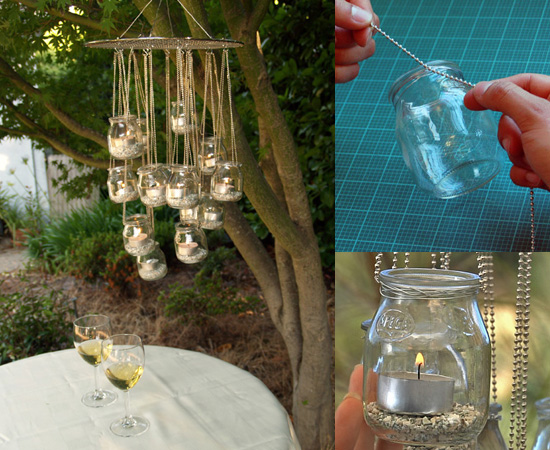As dusk falls, my husband and I gravitate toward the garden. We can usually be found lounging in our hammock, sharing dinner with friends, or just enjoying an evening stroll. At these times, the halogen patio light outside our back door seems too harsh. Instead, we turn to candlelight to set a mood.
I’ve made candle holders from antique tea cups found at thrift shops and from inverted garden cloches hung with twine from tree branches. My favorites, however, are my punched-tin lanterns. They add a folk-art touch to the garden and are fun and easy to create. Most of the materials can be found in the recycling bin and in a reasonably well-stocked tool shed. The designs I use are often inspired by the plants and trees around my house, and they reflect the overall feeling of my garden—casual and personal.
Supplies you will need
- A variety of leaves with interesting, bold shapes
- Sheets of vellum paper
- Masking tape
- Permanent black marker
- Metal cans, labels removed
- Sand and water
- Towel
- Hammer and nails
- Spray paint in white or off-white as well as colors of your choice
- Copper wire
- Votive candles
1. Prepare the can
Fill the can with sand, add water, and place it in the freezer. The frozen mixture will give structure to the can and a surface against which to pound, so that the can does not become misshapen. Water expands significantly when frozen and will cause the can to swell if used without the sand. Filling the cans with sand first, then water, greatly reduces the amount of water in the can, minimizing the expansion.
2. Make the template
Select a leaf that will fit the size of the can nicely and trace its shape with a permanent marker onto a long piece of vellum paper. Don’t worry about including lots of details because only the basic shape will show up on the final product. If you prefer, you can use the template of a ginkgo leaf on the right. Blow it up on a photocopy machine for a full-size leaf.
3. Position the design
When the water is completely frozen, take the can out of the freezer and tape the vellum paper tightly around the can, positioning the leaf shape exactly where you want it. If the paper does not go all the way around the can, make sure the tape secures both ends of the vellum, since it will not stick to the can when condensation begins to form.
4. Punch the holes
Rest the can on its side on a folded towel to keep the can from rolling around and to protect the work surface. With a hammer and a sharp nail, punch holes though the paper and into the can along the lines of the design. I like to punch larger holes at the peaks in the leaf shape, at the intersections of veins, and along the stem to give some dimension to the design. I also tend to space the holes on the edges of the leaves closer together than those in the veins, giving them more weight. Change nails frequently, as they dull quickly after repeated punches. When the leaf is finished, make two large holes opposite each other at the top of the can for hanging wire.
When the design is complete, remove the vellum paper, invert the can in a bowl, and allow it to thaw. Remove the sand and water, rinse the can well, and allow it to dry completely.
5. Paint the lantern
Spray the inside of the lantern with white paint to diffuse the candlelight and give the lantern a brighter glow. All that’s required is a couple of quick shots of white or off-white spray paint aimed into the can from 3 to 4 inches above the opening. Then choose a color for the outside and spray on two light coats, allowing the paint to dry between coats. This paint is not only decorative but also offers a little protection from the elements if you leave your lanterns outside. Alternatively, you could skip the paint and just allow your lantern to rust over time.
6. Add the wire and a candle
If you want to hang your lantern, cut about 24 inches of wire and insert the ends into the hanging holes from the outside, twisting the ends back over the top and around the wire again. I like to place a votive candle inside a glass holder for ease of use and even better light diffusion. If you don’t use a votive glass, I recommend using a tealight candle or putting about a half inch of sand in the bottom of the can so that a completely melted candle is easy to take out and replace.
















 Punch the first hole in the side of the cap. Using the nail, line up this hole and the center of the cap (where you see a mark in the plastic) to see where to pierce the second hole. Position the nail and hammer it in with one hard blow to make the hole. The two holes are now lined up.
Punch the first hole in the side of the cap. Using the nail, line up this hole and the center of the cap (where you see a mark in the plastic) to see where to pierce the second hole. Position the nail and hammer it in with one hard blow to make the hole. The two holes are now lined up.
























